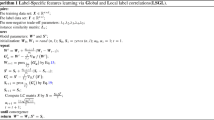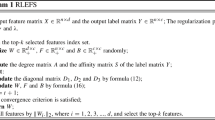Abstract
Multi-label learning arises frequently in various domains including computer vision and machine learning and has attracted great interest in the last decades. However, current multi-label classification methods may be deficient in many real applications with following two constraints: (1) lack of sufficient labeled data and (2) high dimensionality in feature space. To address these challenges, in this paper, we propose a new semi-supervised multi-label feature learning algorithm named as label enlarged discriminant analysis. Different from supervised multi-label learning methods, the proposed algorithm can utilize the information from both labeled data and unlabeled data in an effective way. The proposed algorithm enlarges the multi-label information from the labeled data to the unlabeled data through a special designed multi-label label propagation method. Thus, it can take both labeled and unlabeled data into consideration. It then learns a transformation matrix to perform feature learning to reduce the high dimensionality by incorporating the enlarged multi-label information. In this way, the proposed algorithm can preserve more discriminative information by utilizing both labeled and unlabeled data simultaneously. We have analyzed in theory and extensive experimental results are carried out upon several data sets. They all validate the effectiveness of the proposed algorithm.




Similar content being viewed by others
Notes
References
Belkin M, Matveeva I, Niyogi P (2004) Regularization and semi-supervised learning on large graphs. In: COLT, pp 624–638
Cai Z, Zhu W (2017) Multi-label feature selection via feature manifold learning and sparsity regularization. Int J Mach Learn Cybern 9(8):1321–1334. https://doi.org/10.1007/s13042-017-0647-y
Chapelle O, Weston J, Schölkopf B (2003) Cluster kernels for semi-supervised learning. In: NIPS, pp 601–608
Charte F, Rivera AJ, Jesus MJD, Herrera F (2014) Concurrence among imbalanced labels and its influence on multilabel resampling algorithms. In: HAIS, pp 110–121
Chen G, Song Y, Wang F, Zhang C (2008) Semi-supervised multi-label learning by solving a sylvester equation. In: SDM, pp 410–419
Fisher RA (1936) The use of multiple measures in taxonomic problems. Ann Hum Genet 7:179–188
Gibaja E, Ventura S (2015) A tutorial on multilabel learning. ACM Comput Surv 47(3):1–38
Gretton A, Bousquet O, Smola A, Scholkopf B (2005) Measuring statistical dependence with Hilbert–Schmidt norms. In: ALT, vol 16. Springer, pp 63–78
Guo B, Hou C, Nie F, Yi D (2016) Semi-supervised multi-label dimensionality reduction. In: ICDM
Guo Y, Schuurmans D (2012) Semi-supervised multi-label classification. In: ECML/PKDD, pp 355–370
He X, Niyogi P (2003) Locality preserving projections. In: NIPS, pp 153–160
Herrera F, Charte F, Rivera AJ, Del Jesus MJ (2016) Multilabel classification: problem analysis, metrics and techniques. Springer, Berlin
Horn RA, Johnson CR (2013) Matrix analysis. Cambridge University, New York
Huang J, Li G, Huang Q, Wu X (2017) Joint feature selection and classification for multilabel learning. IEEE Trans Cybern 48:1–14
Jolliffe I (1986) Principal component analysis. Springer, Berlin
Kang F, Jin R, Sukthankar R (2006) Correlated label propagation with application to multi-label learning. In: 2006 IEEE computer society conference on computer vision and pattern recognition, pp 1719–1726
Kong X, Ng MK, Zhou ZH (2013) Transductive multi-label learning via label set propagation. IEEE Trans Knowl Data Eng 99:704–719
Li Y, Guo L (2007) Least squares linear discriminant analysis. In: ICML, pp 1087–1093
Liu W, Zhang M (2011) Transductive multi-label learning via label set propagation. J Mach Learn Res 25:197–212
Liu Y, Jin R, Yang L (2006) Semi-supervised multi-label learning by constrained non-negative matrix factorization. In: AAAI, pp 421–426
Liu Y, Liu Y, Wang C, Wang X, Zhou P, Yu G, Chan KCC (2015) What strikes the strings of your heart? Multi-label dimensionality reduction for music emotion analysis via brain imaging. IEEE Trans Auton Mental Dev 7(3):176–188
Nie F, Xiang S, Jia Y, Zhang C (2009) Semi-supervised orthogonal discriminant analysis via label propagation. Pattern Recognit 42:2615–2627
Nie F, Xiang S, Liu Y, Zhang C (2010) A general graph-based semi-supervised learning with novel class discovery. Neural Comput Appl 19:549–555
Nie F, Xu D, Li X, Xiang S (2011) Semi-supervised dimensionality reduction and classification through virtual label regression. IEEE Trans Syst Man Cybern Part B (Cybernet) 41:675–685
Paige CC, Saunders MA (1982) Algorithm 583: LSQR: sparse linear equations and least squares problems. ACM Trans Math Softw 8(2):195–209
Plaza A, Plaza J, Valencia D (2007) Impact of platform heterogeneity on the design of parallel algorithms for morphological processing of high-dimensional image data. J Supercomput 40:81–107
Qian B, Davidson I (2010) Semi-supervised dimension reduction for multi-label classification. In: AAAI, pp 569–574
Schapire RE, Singer Y (2000) Boostexter: a boosting-based system for text categorization. Mach Learn 39:135–168
Wang H, Chris D, Huang H (2010) Multi-label linear discriminant analysis. In: ECCV, pp 126–139
Wang H, Huang H, Ding C (2009) Image annotation using multi-label correlated green’s function. In: ICCV, pp 197–212
Wei Q, Yang Z, Junping Z, Wang Y (2009) Semi-supervised multi-label learning algorithm using dependency among labels. In: ICMLC, pp 112–116
Wu L, Zhang ML (2013) Multi-label classification with unlabeled data: an inductive approach. ACML 29:197–212
Ye J (2007) Least squares linear discriminant analysis. In: ICML, pp 1087–1093
Ye J, Ji S, Sun L (2011) Multi-label dimensionality reduction. Chapman and Hall, London
Yu D, Fu B, Xu G, Qin A (2018) Constrained nonnegative matrix factorization-based semi-supervised multilabel learning. Int J Mach Learn Cybern 10(5):1093–1100. https://doi.org/10.1007/s13042-018-0787-8
Yu K, Yu S, Tresp V (2005) Multi-label informed latent semantic indexing. In: ACM SIGIR, pp 258–265
Yu Y, Pedrycz W, Miao D (2014) Multi-label classification by exploiting label correlations. Expert Syst Appl Int J 41:2989–3004
Yu Y, Wang J, Tan Q, Jia L, Yu G, Yu Y, Wang J, Tan Q, Jia L, Yu G (2017) Semi-supervised multi-label dimensionality reduction based on dependence maximization. IEEE Access 5(99):21927–21940
Zhang CG, Zhang XH (2013) Graph-based semi-supervised multi-label learning method. In: MEC, pp 1021–1025
Zhang ML, Zhou ZH (2007) ML-KNN: a lazy learning approach to multi-label learning. Pattern Recognit 40:2038–2048
Zhang Y, Zhou ZH (2010) Multilabel dimensionality reduction via dependence maximization. ACM Trans Knowl Discov Data 4:1503–1505
Zhao M, Zhao Z, Zhang H (2013) A soft label based linear discriminant analysis for semi-supervised dimensionality reduction. In: IJCNN, pp 83–97
Zhou D, Bousquet O, Lal TN (2004) Learning with local and global consistency. In: NIPS, pp 321–328
Zhu X, Ghahraman Z, Lafferty J (2003) Semi-supervised learning using Gaussian fields and harmonic functions. In: ICML, pp 912–919
Zhu X, Goldberg AB (2009) Introduction to semi-supervised learning. Synthesis Lectures on Artificial Intelligence and Machine Learning. Morgan & Claypool Publishers. https://doi.org/10.2200/S00196ED1V01Y200906AIM006
Acknowledgements
This work was supported by the NSF of China under Grant 61922087 and Grant 61906201, and the NSF for Distinguished Young Scholars of Hunan Province under Grant 2019JJ20020. Chenping Hou is the corresponding author.
Author information
Authors and Affiliations
Corresponding author
Additional information
Publisher's Note
Springer Nature remains neutral with regard to jurisdictional claims in published maps and institutional affiliations.
Rights and permissions
About this article
Cite this article
Guo, B., Tao, H., Hou, C. et al. Semi-supervised multi-label feature learning via label enlarged discriminant analysis. Knowl Inf Syst 62, 2383–2417 (2020). https://doi.org/10.1007/s10115-019-01409-3
Received:
Revised:
Accepted:
Published:
Issue Date:
DOI: https://doi.org/10.1007/s10115-019-01409-3




